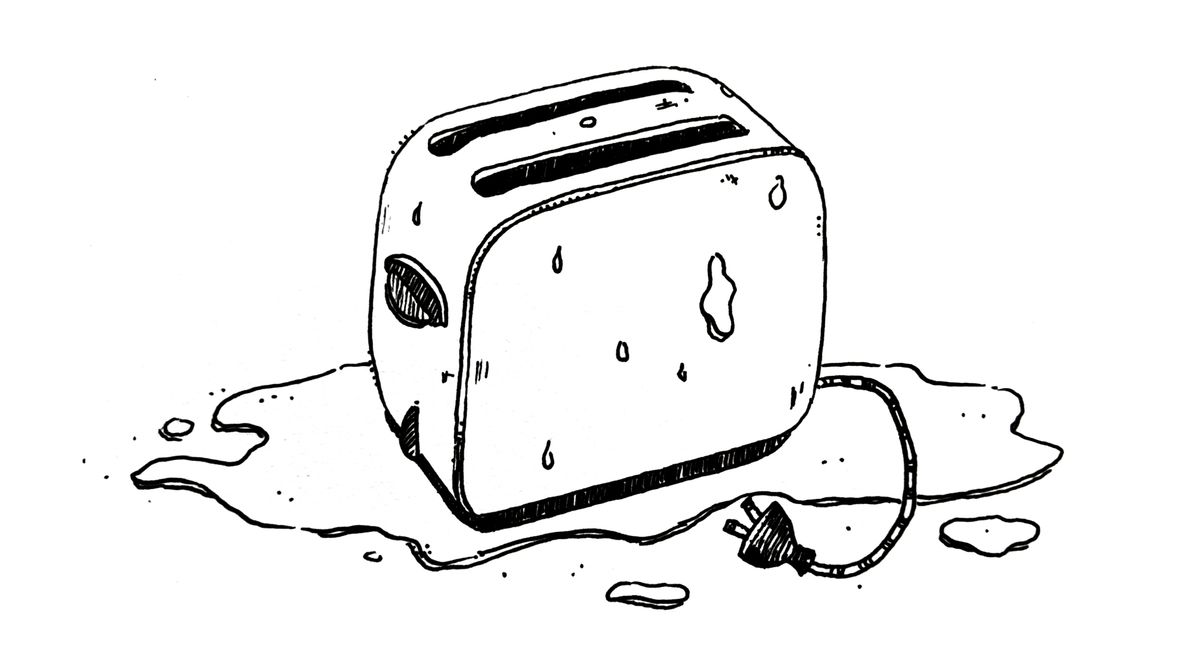DIY: Nemesis
For some, DIY is naught but a spectrum of disasters

The water filter was due for replacement around April, so naturally I bought a new one in June and got to installing it in July.
I’m not sure what happened to May.
Before replacing the filter, there are two valves to turn off: the one under the sink, which sends the water through the flow regulator and then the filter; and the second above the sink, the filter tap itself.
Last year when I replaced the filter, I turned the tap off but forgot about the second valve beneath the sink. I unscrewed the filter unit and pressurised water exploded over me and everything: the toaster, the waffle maker, and all shapes of under-the-sink garbage.
When my family came home, I was laying out half our kitchen on the deck to dry in the sun.
“Why are you drying the toaster, Papa?” my daughter Ida asked.
“Oh, no reason.”
This year I was fractionally smarter. Partly to give myself some more space, but mostly to protect myself against the same mistake, I rolled up my sleeves and emptied out the space under the sink entirely: pots, pans, baking trays, the large red toaster, the waffle maker, jars containing unidentified goop, leaking cleaning-product bottles of indeterminate origin, a single vinyl glove, some shoe polish, and a replacement dish-brush head still in its packet despite looking partly used.
- – — – -
I’m not a practical person. Well, that’s what I’ve become accustomed to saying, in defence. Kurt Vonnegut once wrote: “We are what we pretend to be. So we must be very careful about what we pretend to be.”
We are what we pretend to be. So we must be very careful about what we pretend to be.
A person with the kind of practicality I’m referring to wouldn’t flinch from fixing a leaking tap, affixing a home-made shelf to a wall, or tearing down a wall to enlarge a room. There’s a base-level cultural expectation in New Zealand that: (a) you’ll just as a matter of course possess the practical skills to DIY your way out of anything; or (b) you’re a quick study and could attain these skills at any time. I wonder if this is driven by frugality, or an entrenched stoicism which renders seeking help unpopular, or a shortage of tradespeople and supplies. Whatever the reason, it’s an unspoken dictum: Do It Yourself. (Or Thou Shalt Feel Unworthy.)
I could devote some brain energy to learning some new DIY skills. But these days my brain feels mostly expended, especially during the week, after writing in the early morning then doing my main job for the rest of the day. Is there sufficient energy left? If this sounds a slim excuse, a veil for my laziness, that’s because it is.
I’m also not a fan of stepping across a DIY threshold of no return, whereby I can’t roll things back. Say I tear down a wall that was supposed to bear weight – how would I put the wall back up? It seems counterproductive to even invite such a scenario, because you may well end up having to get an expert to help you fix the disaster you’ve set in motion – and now you’ve actually lost that time you devoted to a hopeless venture. It’s a defeatist view, I know, but when you get busy, you’ve gotta prioritise. And tinkering with the innards of my house – at the risk of a leak, malfunction, or catastrophic loss of structural integrity – is not something I would put high on the to-do list. If on the list at all.
So while replacing the water filter isn’t particularly intimidating or involved, and barely even falls within the DIY category, I put it off for as long as possible. Even though I’d done it before. Replacing the water filter should be the level of practicality I can handle. The keyword is “should”.
- – — – -
I got down on my knees, turned both valves off, and gingerly unscrewed the under-sink unit. I had a towel ready, expecting malpractice. But aside from a few drips, there was no geyser of incorrectly routed water. A promising start.
After I removed the old charcoal filter, I started to clean out the inside of the unit. I took out the black O-ring, which forms a seal at the bottom of the internal screw thread, preventing water from being driven around the thread by the pressure and out through the gap where the unit is sealed.
Once I’d inserted the new filter and screwed it all back together, the water filter did issue forth a little water. First try! But then the tap started to cough and splutter more than I’d expect from a few initial air bubbles; and underneath I could see water dribbling out of the seal, onto the wood of the under-sink shelving.
Sigh. I took the unit apart again, dried everything off, including the inside of the thread, and screwed it all together much firmer, this time using the filter-tightening doohickey I’d bought with the filter. I was nervous about the tightening; I didn’t want to slip, pop an internal rivet, and add “hernia operation” to the week’s to-do list.
I didn’t want to slip, pop an internal rivet, and add “hernia operation” to the week’s to-do list.
I turned the tap on again, but this time water sprayed everywhere, all over the wall underneath the sink. The extra tightening seemed to be working against me, working the water out through the tiny gap at a higher pressure.
I turned everything off. Sitting in the middle of my dismantled kitchen, I went through the stages of DIY despair: ranting, swearing, moaning, sweating.
- – — – -
My wife Vic called the water filter shop guy, who was just down the road from us. Vic said she was calling for help on my behalf, but she later also admitted that she had hoped the Shop Guy would come over to our house and do it for me, to put me out of my misery.
“Did you put some kind of lubricant on the O-ring?” Shop Guy asked over speaker phone.
“No, I didn’t. But I’ve never bothered with that any other time, and it’s worked out fine. This is the first time this kind of thing has happened.” (Well, it was the first time this had happened after I’d put the filter in.)
“I don’t suppose you have any O-ring lubricant?” Shop Guy said. No, not something I just keep around the place, I told him.
“You can just use Vaseline instead, or even some cooking oil will do, just to get that good seal.” I nodded along, but felt myself getting frustrated again.
“It’s in the instructions,” Shop Guy added, driving home that really the problem here was me going off-book.
After Shop Guy hung up, I took the filter unit apart for the third time, ready to dry the thread and grease up that O-ring.
Only when I opened it up, spilling water all over my hands, which ran down my arms and into my armpits, I couldn’t see an O-ring. I looked around, and there, on a nearby chair, next to the tea towel I’d used to dry it, was the O-ring.
The problem was the O-ring after all. Namely: My inability to include the O-ring in the apparatus.
The filter worked fine after I put the greased O-ring back in and screwed it all back up. Watertight.
- – — – -
A primary school project I’d done on the ill-fated Challenger space mission came to mind. They’d blamed that on O-rings. Specifically the behaviour (reduced elasticity) of the rocket booster O-rings in the low temperature of that launch morning.
It seems that to work with O-rings is to court disaster. We need engineers to create products without O-rings.
If nothing else but to protect us from ourselves.



Comments ()